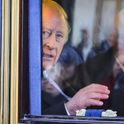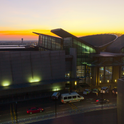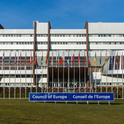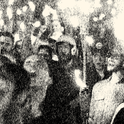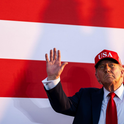Across Pakistan and India, the legacy of Britain’s 300 years as a colonial power is all around—physically evident in the architecture. It’s there in the distinctive buildings of Lutyens’ Delhi; the clock tower at Karachi’s Empress Market’ the wide streets originally built for British officers in Lahore.
But the most profound legacy was created by how the British left—hurriedly, in August 1947, carving the country in two: India for the Hindus, and Pakistan for the Muslims. This set in motion one of the largest migrations of people the world has ever seen. This blood-soaked history is also, more subtly, built into the physical environment. In Muslim-majority Pakistan, it survives in the Sikh temples glimpsed amid Lahore’s tourist district, or the Hindu symbols carved into lattices in Karachi’s old town. Even today, 70 years later, property disputes are pursued over houses left behind by Hindus fleeing Karachi, or Muslims fleeing Delhi. Many thought they would be back to sort out their affairs within a few months or years; for most, this did not come to pass.
After thousands of years co-existing peacefully, at Partition communities turned on each other with shocking aggression and brutality. The numbers speak for themselves: at least 12 million people were displaced, and between one and two million lost their lives.
The Pakistani historian Ayesha Jalal has described Partition as “a defining moment that is neither beginning nor end,” something that “continues to influence how the peoples and states of postcolonial South Asia envisage their past, present and future.”
Yet there has been a strange reticence about remembering this cataclysmic event. On the 70th anniversary of Partition, the last generation who have vivid memories of 1947 are dying out, lending a particular urgency to the project of collating a record. The Guardian, BBC and New York Times are just some of the media outlets appealing for readers to share their stories. Various historians have recorded oral testimonies of Partition over the years, and now several grassroots organisations are also working to do this on a major scale.
The largest is the 1947 Partition Archive, a US-based project established in 2010 that has so far collected 4,500 testimonies from across South Asia. Founder Dr Guneeta Singh Bhalla, who started off recording on her own at weekends and in the evenings, says that the ultimate goal is to collect at least 10,000. She says her work was inspired by the Hiroshima Peace Memorial.
“I come from a family affected by Partition, I have grown up hearing the stories and I was really aware of the disconnect between the official narrative and the folk narrative,” she says. “Seeing the Hiroshima archive, I realised nothing really hits you like a survivor account. You feel on a visceral level what it was like to go through that.”
Stories for the 1947 Partition Archive are partly sourced through what Bhalla calls “citizen historians”—individuals recording their grandparents or other older relatives and family friends—but also through teams of scholars travelling to more rural areas to gather stories there. At times, they have encountered suspicion. “Partition in itself was not normal to talk about when we first started. So it would take us a lot of time to convince people we were not government spies and we were not there to do any harm to them,” she says. “Now, the whole idea of talking about Partition is becoming normalised.”
The Citizens Archive of Pakistan, a centre for education, heritage and culture which has collected over 2,400 oral testimonies of Partition since 2007, faced similar issues initially.
"70 years later, people are still looking for their loved ones who went missing on the journey from India to Pakistan"“When the project started, nobody took it seriously or understood why such narratives needed to be collected,” says Aaliyah Tayyebi, CAP’s senior project manager. “It took a lot to educate people about the work we were doing and why it was important.”
As the stories began to be collected and the project gained momentum, people began to see the value in recording this lived history. “People talk about violence, riots, starvation, loss of people, loss of their homes,” says Tayyebi. “A few have told us that to this date, 70 years later, they are still looking for their loved ones who went missing on the journey from India to Pakistan. They want their memories to be understood.”
Oral history is particularly important given that there has been no major public reckoning with the seismic event of Partition. There are no memorials for the dead, no national reflection as there is today in Germany after the horrors of the Holocaust, no reconciliation committees as in Rwanda after the genocide. There are several possible reasons for this: not least the circumstances of Partition, which involved not only independence from years of subjugation but the birth of two new countries.
“There was a huge nation-building exercise,” says Bhalla. “India is such a new concept—but it’s taught in schools as if it’s an ancient country that has been around in its current form forever.”
There is a clear cognitive dissonance between the deep trauma felt by many and the patriotism and enthusiasm engendered by creating a new nation.
“When people in the west speak about Partition, they speak about the event itself and leave it there, but for the people of South Asia, it was just a beginning,” says Tayyebi. “It was the conclusion to the British power, but it was the beginning of a new era. When we speak to people, even those who suffered and lost a lot, along with all of that was hope. I have had innumerable people tell me, ‘of course we left with the clothes on our back—because we believed in what we were venturing forth towards’.”
Bhalla also suggests that the West has a different relationship with history: “It was not in our culture to record things for posterity in South Asia.” Yet there is a growing feeling that it is vitally important for this history to be engaged with and confronted – and to preserve the collective memory so that it outlives those who were there. “Partition is fundamentally related to the Indian and Pakistani identities,” says Bhalla. “And it lies at the heart of the conflict at our border which is absorbing so many resources.”
Collecting stories of Partition is, in itself, a way of reflecting on what so many went through; a reflection that there was barely space for at the time, as new nations were formed and wars were fought. “We can learn from it,” says Tayyebi. “To make sure that we don’t repeat the losses we had to endure.”

